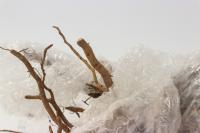1. Soil
Succulent plants are suitable to use dry, sterile and insect free soil with good water permeability. Beginners recommend using perlite and coconut bran mixed (1:2) to make the matrix, which is suitable for the growth needs of most succulent plants. For the dry climate in the north, it is necessary to increase the moisture retention performance of the soil; For the humid and rainy weather in the south, it is necessary to improve the drainage performance of the soil
2. Illumination
The growth of succulent plants requires sufficient light. Too little light or dark environment will lead to overgrowth. When raising meat indoors, it is suitable to place it in a sunny window or balcony. If the temperature is too high in summer, a shading net with a shading rate of 70% can be used, and the sun exposure at 12-15 hours can be avoided; Sunshine can be fully accepted in other seasons

3. Moisture
The principle of watering succulent plants is to water less and thoroughly to avoid rotten roots and black rot caused by ponding in the basin; Too much water is not conducive to the modeling of succulent plants, making them grow in vain. Spring and autumn are the fleshy growing season, and the best time to water is when the lower leaves begin to wither; Summer is the season of meat dormancy. Spray water is the main way to keep the surface of the basin moist. Watering times should be reduced in winter
4. Temperature
The origin of succulent plants is South Africa, and the most suitable growth temperature is between 12 and 28 degrees Celsius. Therefore, spring and autumn are the most vigorous seasons for succulent plants. When raising more meat at home, ensure that the room temperature is above 8 ℃ in winter and below 35 ℃ in summer, and pay attention to ventilation and cooling

5. Fertilizer
Succulent plants have low dependence on fertilizer, but moderate fertilization can promote their healthy growth. The principle of thin fertilizer and frequent application should be followed in multi meat fertilization. Changing pots in spring and autumn is the best time for fertilization; During the dormancy period, fertilization must be stopped to avoid rotten roots
6. Summary
The most important aspect of raising more meat is to maintain sufficient light and moderate watering. Friends raising at home should pay attention to that the room temperature should not be too low or too high, and use the culture soil with good water permeability


 jackfruit
jackfruit snake plant
snake plant hibiscus
hibiscus hydrangea
hydrangea lavender
lavender Green roses climb al...
Green roses climb al... If you don't pay att...
If you don't pay att... Management of four g...
Management of four g...

































